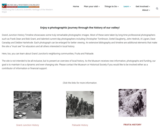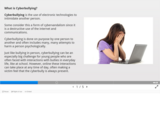
This LO covers how to create both the in-text citation and works cited citation for presentations.
- Subject:
- Composition and Rhetoric
- English Language Arts
- Material Type:
- Interactive
- Provider:
- Michigan Virtual
- Date Added:
- 04/27/2022

This LO covers how to create both the in-text citation and works cited citation for presentations.

This LO introduces in-text citations and discusses how they connect to the works cited page.

This LO demonstrates how to create in-text citations for tricky situations including more than one author, multiple quotes by the same source in a paragraph, corporate authors, electronic sources.

This LO introduces how to correctly format a block quote following MLA 8.

This resource provides a comprehensive, digestible slideshow about stereotypes. This slide show can be used inside the classroom to supplement a lesson plan, for independent learning, or as a homework assignment.

This resource offers an overview of Cybercrime.

Codes of Ethics Statements Slideshow

This resource offers a definition of cyberbullying.

A slideshow defining homicide and murder.

In this unit, students will learn about plants/trees and will inquire about the ways all living things need plants. Students speak from the point of view of animal and will persuade someone not to cut down their tree.

In this blended learning unit, student will explore the U.S. Government from the Articles of Confederation through the writing of the Constitution. Students will be able to recognize the reasons why the founding fathers included the ideas and principles in these documents based on historical perspectives.

Introduction and use of multiple tools in Seesaw in order to improve expressive language and intelligibility skills for speech and language students.

Yes, the unit covers the reasons the Japanese bombed Pearl Harobr, the planning of Pearl Harbor, the execution of Pearl Harbor and the aftermath of Pearl Harbor. It includes a plan of the day to day plan, articles, primary sources, secondary sources, digital reviews, and on line assesments.

In this project, students identify areas at highest risk of flooding and landslides during a major rain event. They first explore the region's dramatic geography and identify how the most flood-prone areas correspond with large population centers. Then, they determine where landslides are most likely to occur and summarize the population in these at-risk areas. Overall, students get a picture of the dangers faced in Boulder County and the costs associated with rebuilding in the wake of catastrophe.

Students will analyze how the market areas for specific chain stores change based on the type of store.
GeoInquiries are designed to be fast and easy-to-use instructional resources that incorporate advanced web mapping technology. Each 15-minute activity in a collection is intended to be presented by the instructor from a single computer/projector classroom arrangement. No installation, fees, or logins are necessary to use these materials and software.

Students will explore the spatial patterns of the Human Development Index (HDI) to identify regional patterns and causal factors in the data.
GeoInquiries are designed to be fast and easy-to-use instructional resources that incorporate advanced web mapping technology. Each 15-minute activity in a collection is intended to be presented by the instructor from a single computer/projector classroom arrangement. No installation, fees, or logins are necessary to use these materials and software.

Students will investigate how connections are made across Earth, focusing on advancements in transportation and technology.

Description: This lesson was created for a 9th grade integrated biology/English classroom with a focus on out door learning. In this lesson, students will practice their scientific observation skills and reflect on their experience in this out door observation activity. Students will also take these initial observations and extend them in their writing as they explore various forms of figurative language. Finally, the reflections will be posted on their blog for their classmates to view and respond to as we begin to practice feedback on each other's writing.
Note: Before beginning this unit, decide on where students will house their blog posts to allow for feedback from peers. Keep in mind the time students might need to spend developing and working with the blog before actually posting to it. A Google Classroom discussion post may work as well, or even better. Additionally, this lesson also addresses the NGSS Science & Engineering Practices.

For this lesson, students will learn through a video and powerpoint presentation how to cite in-text in APA format. Students will have an opportunity to practice citing in-text before citing in their own APA research paper.

For these lessons, students will be taken through a variety of activities to learn about plagiarism. They will learn what plagiarism is, the consequence for it, how to paraphrase writing, when to use direct quotes, and how to cite. This is a wonderful webquest for students to go through.